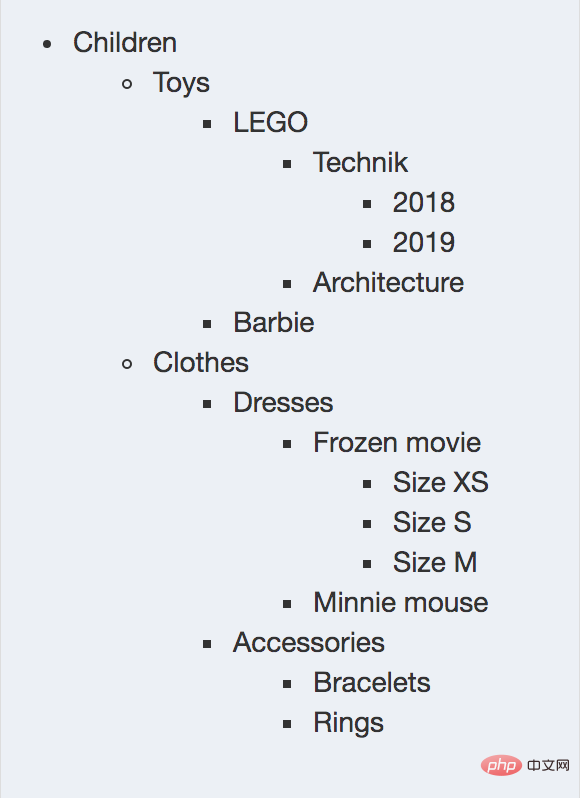
The following is developed by LaravelThe introductory tutorial column will introduce you to the method of using Laravel Eloquent's hasMany to develop Infinitus classification. I hope it will be helpful to friends in need!
In online shopping malls, we can often see multi-level classifications, sub-categories, and even Infinitus classifications. This article will show you how to elegantly implement it with Laravel Eloquent.
We will create a micro project to display the classification of children's stores, with a total of 5 levels, as follows:

Database migration
Simple data table structure:
Schema::create('categories', function (Blueprint $table) {
$table->bigIncrements('id');
$table->string('name');
$table->unsignedBigInteger('category_id')->nullable();
$table->foreign('category_id')->references('id')->on('categories');
$table->timestamps();
});There is only one name field, related to itself. Therefore, most parent categories category_id = NULL, and each subcategory has a parent_id
The data table data is as follows:

##Eloquent model And the relationship
First, create a simple hasMany() method in app/Category.php. The category may have its own self-categorization:class Category extends Model
{
public function categories()
{
return $this->hasMany(Category::class);
}
}public function childrenCategories()
{
return $this->hasMany(Category::class)->with('categories');
}Routes and Controller Methods
Now, let us try to display all categories and subcategories as shown in the above example. In routes/web.php, we add the following:Route::get('categories', 'CategoryController@index');
public function index()
{
$categories = Category::whereNull('category_id')
->with('childrenCategories')
->get();
return view('categories', compact('categories'));
}Views and recursive subviews
Finally, render to the page. In the resources/views/categories.blade.php file:<ul>
@foreach ($categories as $category)
<li>{{ $category->name }}</li>
<ul>
@foreach ($category->childrenCategories as $childCategory)
@include('child_category', ['child_category' => $childCategory])
@endforeach
</ul>
@endforeach
</ul><li>{{ $child_category->name }}</li>
@if ($child_category->categories)
<ul>
@foreach ($child_category->categories as $childCategory)
@include('child_category', ['child_category' => $childCategory])
@endforeach
</ul>
@endifThe above is the detailed content of Using Laravel Eloquent's hasMany to develop Infinitus classification. For more information, please follow other related articles on the PHP Chinese website!